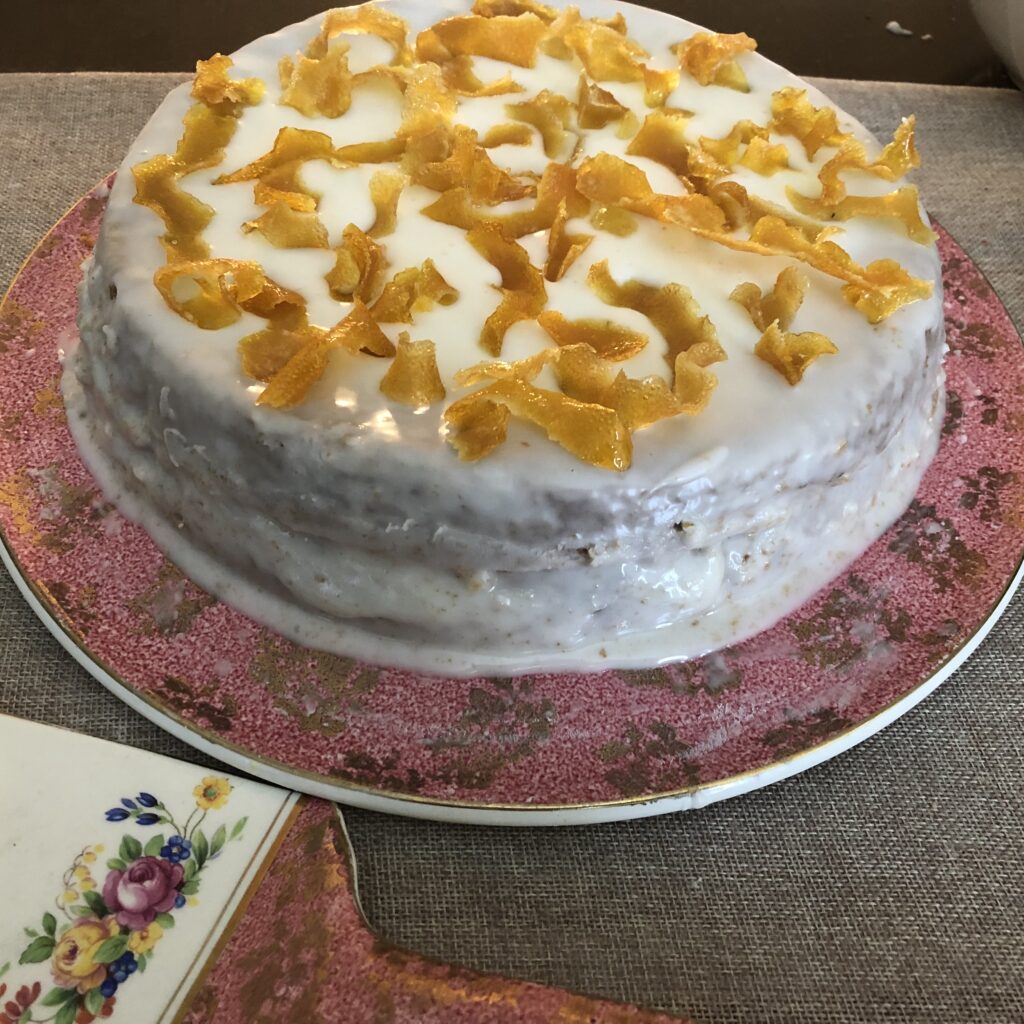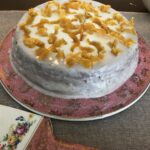This recipe appears in the new Official Downton Abbey Cookbook. Orange cakes were one of the staples of the period and appear in many cookbooks. This version is originally from Margaret Black’s Superior Cookery (1887) uses oranges and lemons and packs a very citrusy punch.
Print
Downton's Orange Layer Cake
This recipe comes from the new Official Downton Abbey Cookbook.
Servings 8 servings
Ingredients
For the Cake
- 1 large orange
- 2 medium lemons,
- 1/2 cup unsalted butter room temperature
- 1 cup superfine sugar
- 1 3/4 cups Flour
- 1 3/4 tsp. baking soda
- 1 pinch salt
- 5 large egg yolks
For Candied Peel
- 1 cup water
- 1 cup Granulated sugar
For the Icing
- 2 cups icing sugar
- 1 pinch salt
For the Filling
- 4 tbsp. orange marmalade
Instructions
Make the Candied Peel
- Use a paring knife to remove the peel from the orange, ensuring you take the least amount of which pith that you can. Try to get long peels of at least 2 inches. Put the peel in a small bowl. Do the same for the lemons, and place them in a separate bowl.
- Juice the oranges and lemons, placing the juice with corresponding peels. Let the juice marinate in the peels for one hour, then strain the juices into separate bowls and reserve along with the peels.
- Put the orange and lemon peels into a small saucepan, add cold water to cover, and bring to a boil over high heat. Boil for a couple of minutes, then drain, discarding the water, and then return the peels to the pan. Repeat twice, discarding the water each time. Meanwhile, line a large sheet pan with parchment paper.
- When you have boiled the peels three times, return them to the pan, and add the 1 cup water and the granulated sugar, and bring to a boil, stirring to dissolve the sugar. Adjust the heat to maintain a simmer and simmer until the peels are tender and any pith has become translucent, 25-30 minutes. Drain well and use a fork to place on the cooking sheet in a single layer to let cool.
- Finally, dry the peels in a low oven 250F until they are crisp but not browned, about 30 minutes. Set aside.
Make the Cake
- Preheat the oven to 350F. Butter the bottom and sides of two 9 inch round cake pans. Line the bottom with parchment paper and butter the parchment. Dust the sides with a mixture of equal parts of superfine sugar and flour, tapping out the excess.
- In a bowl, combine the flour, baking soda and salt. Whisk gently to combine. In a stand mixer with a paddle attachment or a large bowl with a hand mixer, cream together the butter and the superfine sugar on medium speed until smooth and creamy.
- Add egg yolks one at a time, mixing well after every addition, then beat for 10 minutes. The mixture should be pale and fluffy.
- On low speed, beat in 2 tablespoons of the flour mixture to prevent curdling, then add the rest of the flour mixture in three batches, alternating with the reserved orange juice, beginning and ending with the flour mixture, mixing well after each addition.
- Divide the batter evenly between the two prepared baking tins, spreading to the edges.
- Bake until a skewer inserted into the center of each cake layer comes out clean, 20-25 minutes. Let cool completely in the pans on wire racks. Using a blunt knife, loosen the edges of the cakes from the pan sides, then invert the pans onto the racks, lift off the pans, and gently peel off the parchment. Work carefully as the layers are very light and delicate.
Make the Icing
- To make the icing, put the confectioner's sugar, lemon juice and salt in a bowl and mix together.
Assemble the Cake
- Place a cake layer on a serving plate and spread the top with marmalade. Top with the second layer, then using a palette knife or offset spatula, frost the top and sides of the cake with the icing. Sprinkle the top with the candied peel. Let the cake stand for 15 minutes to set the icing before serving.
Notes
The cake rises quite a bit so don't be tempted to use a smaller pan, even though the batter will barely cover the bottom of the 9-inch pan when it goes into the oven. Both cake layers should end up to be 1-inch tall, and when sandwiched together they make a lovely cake. Of course, if you really want to bowl people over, you could double the recipe and stack the four cakes (in this case you'd need to make a bit more icing as well). Such a tall cake wouldn't necessarily be in keeping with the delicate spirit of the times, however.

